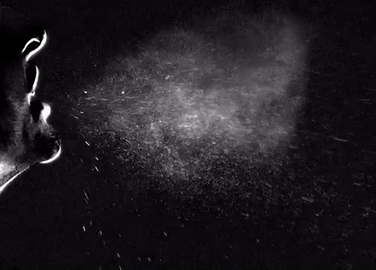Grade Level
All
minutes
15 min - 1 hr
subject
Life Science
Activity Type:
life sciences, family activities, at-home materials, After School Activity
Your challenge is to simulate a sneeze by using a “sneezer” and paint. Once you’ve got the hang of it, you can try different angles, simulated boogers, or mix things up with tissues or your elbow to determine how to reduce sneeze spread. As a bonus, you can change the thickness of your snot simulant. Does it go farther?
Your Sneeze Should:
- – Shoot water, paint, or juice at least three feet
- – Spread both large and small sneeze droplets
- – Not require your own breath or sneeze power – that would spread germs!
- – Be captured on a piece of paper, newsprint, tarp, or sidewalk for others to see how far your sneeze traveled
Did you manage to create a realistic sneeze? Use the link above to submit a photo, video, or story about your sneeze–how far it went, the types of droplets it made, and what you could do to make it more realistic. You’ll have the option to be included in our online Gallery of Excellence and receive a Certificate of Awesome in the mail!
Sneezer Material Ideas:
- – Any squirter you can use to “sneeze” paint with
A dropper, pipette, spray bottle, turkey baster, clean ketchup or dish detergent bottles. - – Water, washable paint, juice, anything wet = Your “snot”
(Try this paint recipe!) - – Newspaper, printer or butcher paper, a drop cloth, tarp, or light-colored sidewalk
- – Bonus things (non-essentials):
- A tape measure or ruler
- A couple facial tissues
- Cornstarch, jello, or mashed potatoes (to make boogers!)
- A smartphone that can do high-speed video to film sneezes
Feeling Stuck? Try This First:
- Put a cup full of water into a plastic baggie, seal or close it up with lots of air trapped inside like a balloon, and take it outside with a toothpick.
- On a piece of dry sidewalk or pavement, squeeze the baggie so that it is about to burst, then poke the baggie with the toothpick that water sprays out of the baggie. Does it make a mixture of small and large drops like a real sneeze? Does it go at least three feet?
Now Challenge Yourself:
Begin experimenting to make a more realistic sneeze! As you experiment, track your results.
- – How far does your simulated snot travel? How widely does it spray?
If you have a ruler or a measuring tape, use it! - – What size droplets travel farthest?
- – What happens if you:
- Hold your sneezer higher up?
- Start with more, or less “snot” in your sneezer?
- Hold a facial tissue an inch or two in front of your sneezer?
- Try a different sneezer, or modify the one you have to make a bigger or smaller opening?
- – What does the thickness of snot do to the sneeze patterns you create? Squeeze a little paint into a separate container, and then either thin it out with water, or thicken it up with a bit of cornstarch. Then sneeze away!
- – How does the amount of air that your sneezer blows change the shape or distance that the sneeze travels?
- – Ready to graph some real data? Quantify your sneeze with this experiment.
More About Sneezes!
Figuring out how far a sneeze can spray snot (and boogers and spit—ew) is an important part of understanding how diseases spread from person to person. Viruses and bacteria that cause colds or other illnesses can travel in the fluids in a sneeze, and sometimes, even when you’re just breathing.
What happened when you held up a tissue before you “sneezed”? What does that tell you about how far people might need to distance themselves in order to be safe from a sneeze? It turns out, studying how liquids (like spit and snot droplets) and air move—a science called fluid dynamics—can help us answer these questions. Here’s a short video about fluid dynamics researcher Lydia Bourouiba and her research on sneezes
Meet the Writer
About Ariel Zych
@arieloquentAriel Zych is Science Friday’s director of audience. She is a former teacher and scientist who spends her free time making food, watching arthropods, and being outside.
